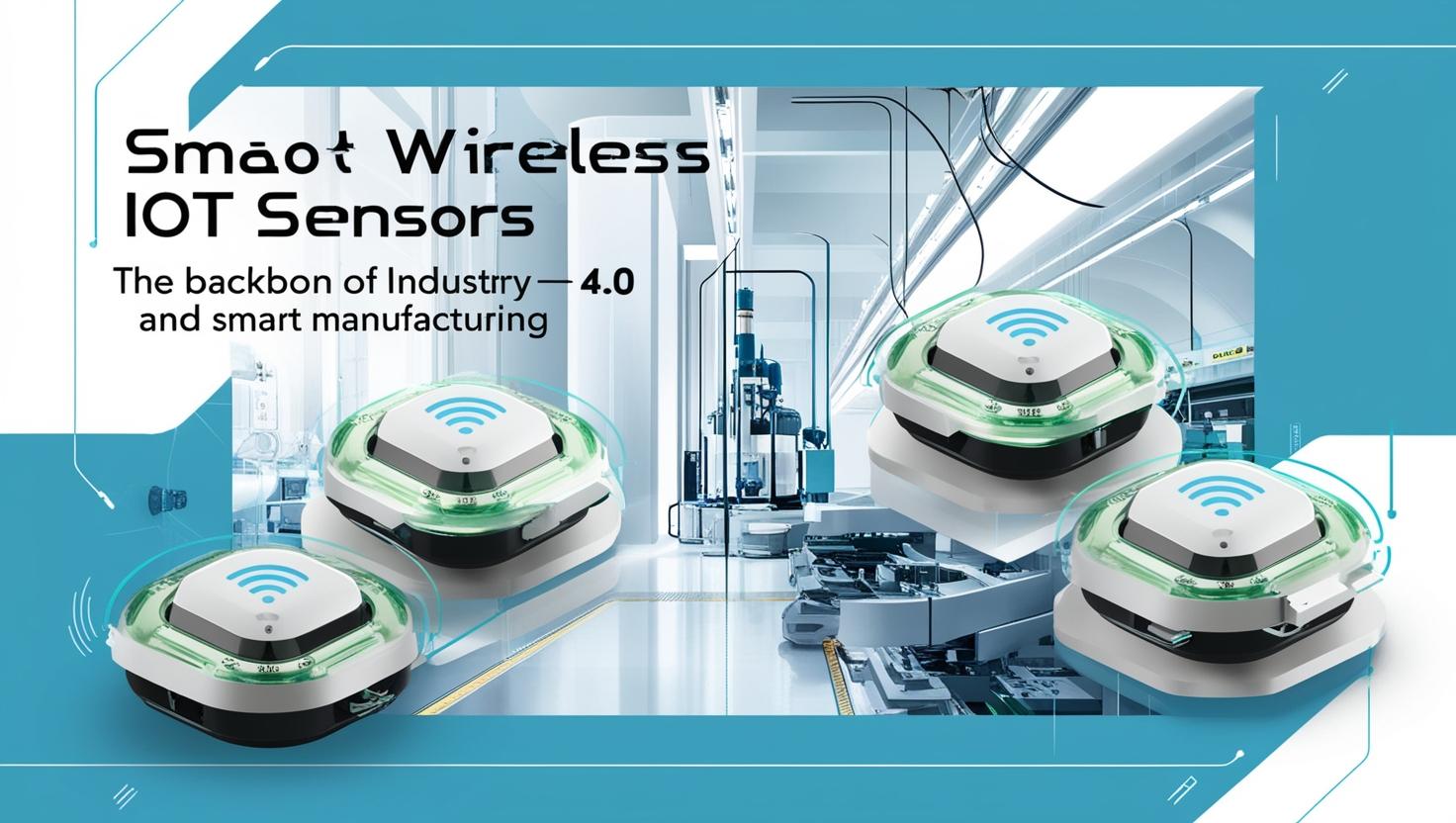In today’s rapidly evolving industrial landscape, Industry 4.0 is leading the charge towards greater efficiency, automation, and innovation. At the heart of this revolution lies wireless IoT sensors, which are playing a crucial role in transforming traditional manufacturing operations into smart, connected ecosystems. These sensors are the backbone of modern smart manufacturing, providing real-time data, enabling automation, and creating smarter processes that drive productivity, cost-efficiency, and sustainability.
As the Wireless IoT Sensors Market continues to grow, let’s explore how these innovative devices are reshaping manufacturing industries and laying the foundation for the future of manufacturing.
What Are Wireless IoT Sensors?
Wireless IoT sensors are devices that collect data from the environment and transmit it without the need for physical wires. These sensors are equipped to measure a wide range of parameters such as temperature, pressure, humidity, motion, and vibration. By leveraging wireless communication technologies like Wi-Fi, Bluetooth, LoRaWAN, and 5G, these sensors can send data to cloud-based platforms or centralized systems for analysis and real-time decision-making.
The use of wireless technology eliminates the need for complex wiring, reducing costs, improving scalability, and enabling greater flexibility in deployment. This is particularly important in industries like manufacturing, where machines and equipment are spread across large factory floors or even multiple facilities.

How Wireless IoT Sensors Power Smart Manufacturing
Smart manufacturing relies heavily on connectivity and automation to optimize production processes. Wireless IoT sensors are central to this shift, helping manufacturers monitor their operations, gather valuable insights, and act on data to improve efficiency and reduce costs. Here’s how wireless IoT sensors are transforming manufacturing:
1. Predictive Maintenance and Asset Management
One of the most significant benefits of wireless IoT sensors in smart manufacturing is predictive maintenance. By continuously monitoring the condition of machinery and equipment, sensors can detect early signs of wear and tear, overheating, vibration anomalies, or mechanical failure. This enables manufacturers to perform maintenance activities before equipment breaks down, preventing costly downtimes and improving overall equipment effectiveness (OEE).
For example, sensors can monitor the temperature and vibration of critical machinery, triggering an alert when readings deviate from normal parameters, allowing operators to schedule repairs at the optimal time. This proactive approach not only saves money but also extends the lifespan of machines and reduces the need for emergency repairs.
Download PDF Brochure @ https://www.marketsandmarkets.com/pdfdownloadNew.asp?id=26520972
2. Real-Time Monitoring and Process Optimization
Wireless IoT sensors allow manufacturers to monitor production processes in real-time, capturing data such as temperature, humidity, pressure, and machine performance. This continuous monitoring enables manufacturers to adjust operations quickly, ensuring that machines are running at their peak efficiency.
With the data provided by these sensors, manufacturers can identify bottlenecks in production, optimize supply chain management, and fine-tune processes to enhance quality control. For example, in the food and beverage industry, IoT sensors can ensure optimal storage temperatures for perishable goods, preventing waste and ensuring product quality.
3. Enhanced Automation and Robotics
IoT sensors play a crucial role in automation and the integration of robotics within manufacturing facilities. By providing sensors to robots and automated systems, manufacturers can enable machines to make intelligent decisions based on real-time data.
For instance, wireless IoT sensors can enable robotic arms to detect when a part is missing, automatically requesting the next step in the assembly process, or adjusting the speed of production based on the volume of parts being processed. This level of automation leads to increased productivity, reduced human error, and improved quality control across the board.
4. Energy Management and Sustainability
Manufacturing processes consume large amounts of energy, and optimizing energy usage is essential for improving both cost efficiency and environmental sustainability. Wireless IoT sensors provide real-time insights into energy consumption at every stage of production, allowing manufacturers to monitor and control energy use more effectively.
For example, sensors can monitor the temperature of industrial machinery, HVAC systems, and lighting systems, automatically adjusting them based on real-time requirements. This reduces energy waste, lowers operating costs, and supports sustainability goals. Moreover, energy-efficient manufacturing processes contribute to a company’s efforts to meet environmental regulations and reduce carbon footprints.
5. Supply Chain and Inventory Management
Wireless IoT sensors play a pivotal role in managing supply chains and inventory. By attaching IoT-enabled sensors to products or assets, manufacturers can track the location, condition, and movement of materials in real-time. This data can be used to optimize inventory levels, improve warehouse management, and enhance product traceability.
For instance, manufacturers can track the movement of raw materials through the supply chain, receiving notifications when stock levels are low, or when inventory has been delayed. Real-time tracking ensures that production runs smoothly without disruption and reduces the risk of shortages or overstocking.
Global IoT sensors industry size
The global IoT sensors industry size is projected to grow from USD 16.0 billion in 2024 to USD 70.1 billion by 2029; it is expected to grow at a CAGR of 34.4% from 2024 to 2029.With the increasing internet penetration rate, IoT is finding applications in retail, consumer electronics, agriculture, automotive, transportation, and other verticals. The continuously increasing number of Internet users worldwide is expected to drive the demand for high-speed, low-cost IoT technology-based devices such as radio frequency identification (RFID) tags, barcode scanners, and mobile computers. This would result in an increased demand for sensors.

The Growing Wireless IoT Sensors Market
The Wireless IoT Sensors Market is experiencing rapid growth, driven by the increasing adoption of Industry 4.0 technologies and the push towards more connected, data-driven manufacturing operations. According to recent market reports, the market for wireless IoT sensors is projected to continue expanding, with key drivers including:
- Increased demand for automation in manufacturing processes.
- The need for real-time data to optimize operations and improve decision-making.
- The growth of smart factories and industrial IoT (IIoT) systems.
- Advancements in wireless communication technologies, including 5G, which offer greater speed, range, and reliability for IoT devices.
As more manufacturers recognize the benefits of IoT technology, the adoption of wireless IoT sensors will continue to grow across sectors like automotive, food and beverage, electronics, and chemicals. These sensors are helping companies increase efficiency, reduce costs, improve product quality, and stay competitive in a rapidly changing market.
The Future of Wireless IoT Sensors in Smart Manufacturing
The future of wireless IoT sensors in manufacturing is incredibly promising. As sensor technology continues to evolve, we can expect even more advanced sensors capable of monitoring a wider range of variables with greater precision and reliability. Additionally, the integration of artificial intelligence (AI) and machine learning (ML) will allow manufacturers to not only monitor their operations but also make predictive and automated decisions based on sensor data.
The use of edge computing will also become more prevalent, allowing data processing to occur closer to the source, reducing latency and improving the speed at which decisions are made. As 5G networks become more widespread, the connectivity and performance of IoT sensors will improve, enabling even more complex and data-heavy applications across manufacturing environments.
Ultimately, wireless IoT sensors will continue to be the driving force behind the smart manufacturing revolution, helping industries transition to more automated, efficient, and sustainable operations.
Conclusion: Building a Smarter Future with Wireless IoT Sensors
Wireless IoT sensors are laying the foundation for the next generation of smart manufacturing. By enabling real-time monitoring, predictive maintenance, automation, and energy optimization, these sensors are helping manufacturers achieve greater efficiency, reduce costs, and enhance product quality. As the market continues to grow, we will see even more innovative applications of wireless IoT sensors across industries, making manufacturing smarter, more connected, and more sustainable.
As businesses embrace Industry 4.0, wireless IoT sensors will remain a critical component in building a smarter, more efficient future.
Frequently Asked Questions (FAQ) – Wireless IoT Sensors Market: The Backbone of Industry 4.0 and Smart Manufacturing
1. What are wireless IoT sensors?
Wireless IoT sensors are devices that collect data from their surroundings, such as temperature, pressure, or motion, and transmit it wirelessly to cloud platforms or other connected devices for analysis and action. They use wireless communication technologies like Wi-Fi, Bluetooth, LoRaWAN, and 5G to send the data in real-time.
2. How do wireless IoT sensors benefit smart manufacturing?
Wireless IoT sensors enable smart manufacturing by providing real-time data on production processes, machine performance, and environmental conditions. This data helps manufacturers optimize processes, reduce downtime, improve efficiency, perform predictive maintenance, and enhance product quality.
3. What is predictive maintenance in manufacturing?
Predictive maintenance uses real-time data from IoT sensors to detect early signs of equipment failure, allowing manufacturers to perform maintenance before issues arise. This reduces downtime, minimizes repair costs, and extends the lifespan of machines.
4. What role do wireless IoT sensors play in energy management?
Wireless IoT sensors help monitor and manage energy usage across manufacturing facilities by tracking parameters such as temperature, humidity, and energy consumption. They enable manufacturers to optimize energy use, reduce waste, and meet sustainability goals, ultimately lowering operating costs.
5. Which industries benefit most from wireless IoT sensors in manufacturing?
Wireless IoT sensors are widely used across various industries, including automotive, food and beverage, electronics, chemicals, and consumer goods. These sensors help companies improve production efficiency, enhance quality control, and streamline operations in all sectors.
6. How do wireless IoT sensors improve supply chain and inventory management?
Wireless IoT sensors provide real-time tracking of inventory, assets, and materials. They help optimize stock levels, improve warehouse management, reduce the risk of stockouts, and enhance product traceability throughout the supply chain.
7. What technologies support wireless IoT sensors?
Wireless IoT sensors rely on various communication technologies such as Wi-Fi, Bluetooth, 5G, and LoRaWAN for data transmission. Advancements in these technologies have made it easier to deploy IoT sensors in manufacturing environments, allowing for greater range, speed, and reliability.
